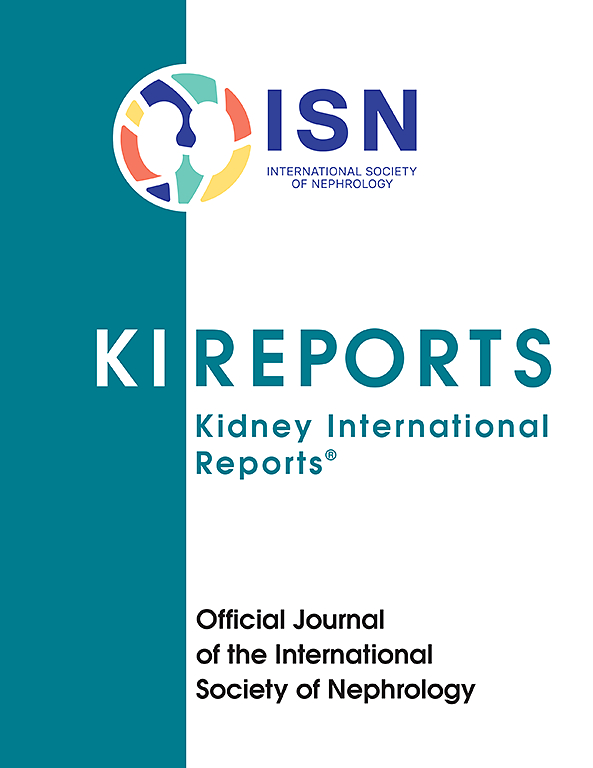The Double-Icodextrin Dose Randomized Controlled Trial of a Double Icodextrin Dose for Older Patients on Incremental Continuous Ambulatory Peritoneal Dialysis
IF 5.7
2区 医学
Q1 UROLOGY & NEPHROLOGY
引用次数: 0
Abstract
Introduction
Icodextrin enhances ultrafiltration (UF) in patients on peritoneal dialysis (PD) but is restricted to 1 bag/d, according to regulatory authorities. The Double-Icodextrin Dose (DIDo) study is a prospective randomized trial investigating the superiority and safety of using 2 bags/d versus 1 bag/d of icodextrin to extend incremental (3 bags/d) continuous ambulatory PD (CAPD) duration in older incident patients.
Methods
After a 2-month “run-in” period, the patients were randomized to 2 icodextrin (“double dose”) + 1 glucose or 1 icodextrin (“single dose”) + 2 glucose dialysates daily. The primary end point was a composite of excessive use of hypertonic dialysates, transfer to another dialysis modality (automated PD [APD], nonincremental CAPD, or hemodialysis) or death at month 9. Secondary end points included mortality, daily UF, technique survival, rates of peritonitis and hospitalizations, and safety at month 18.
Results
Forty-one patients were randomized to double dose and 42 to single-dose icodextrin. Baseline characteristics were well-balanced between groups. At month 9, the proportion of patients who discontinued 3 exchanges/d was similar between those receiving the double and the single icodextrin dose (16 [39%] vs. 21 [50%]; HR: 0.69; 95% confidence interval: 0.35–1.33). The results were similar at month 18. Patients in the double dose icodextrin had higher net UF and less hypertonic dialysates use. Rates of peritonitis, hospitalizations, residual urine output decline and serious adverse events (SAEs) were similar between both groups.
Conclusion
In older patients on incremental CAPD, the double icodextrin dose did not reduce the primary outcome incidence compared with the single icodextrin dose. Significantly enhanced UF was observed in the double icodextrin dose group and no safety issue was identified.

双伊科糊精剂量对老年持续腹膜透析患者的随机对照试验
icodextrin可以增强腹膜透析(PD)患者的超滤(UF),但根据监管部门的规定,icodextrin限制为1袋/天。双icodextrin剂量(DIDo)研究是一项前瞻性随机试验,旨在研究使用2袋/天icodextrin与1袋/天icodextrin延长老年事件患者增量(3袋/天)连续动态PD (CAPD)持续时间的优越性和安全性。方法经过2个月的“磨合”期后,将患者随机分为两组:每日2次icodextrin(“双剂量”)+ 1次葡萄糖或1次icodextrin(“单剂量”)+ 2次葡萄糖透析液。主要终点是过度使用高渗透析液,转移到另一种透析方式(自动PD [APD],非增量CAPD或血液透析)或第9个月死亡的综合结果。次要终点包括死亡率、每日UF、技术生存率、腹膜炎和住院率以及18个月时的安全性。结果41例患者随机分为双剂量组和单剂量组。各组间基线特征平衡良好。在第9个月,接受双剂量和单剂量icodextrin的患者中停止3次/d交换的比例相似(16例[39%]vs. 21例[50%];人力资源:0.69;95%置信区间:0.35-1.33)。在第18个月时,结果相似。双剂量碘糊精组患者净UF较高,高渗透析液使用较少。两组的腹膜炎、住院率、残余尿量下降率和严重不良事件(SAEs)发生率相似。结论在老年增量CAPD患者中,双剂量的icodextrin与单剂量的icodextrin相比并没有降低主要结局发生率。双剂量组UF明显增强,无安全性问题。
本文章由计算机程序翻译,如有差异,请以英文原文为准。
求助全文
约1分钟内获得全文
求助全文
来源期刊

Kidney International Reports
Medicine-Nephrology
CiteScore
7.70
自引率
3.30%
发文量
1578
审稿时长
8 weeks
期刊介绍:
Kidney International Reports, an official journal of the International Society of Nephrology, is a peer-reviewed, open access journal devoted to the publication of leading research and developments related to kidney disease. With the primary aim of contributing to improved care of patients with kidney disease, the journal will publish original clinical and select translational articles and educational content related to the pathogenesis, evaluation and management of acute and chronic kidney disease, end stage renal disease (including transplantation), acid-base, fluid and electrolyte disturbances and hypertension. Of particular interest are submissions related to clinical trials, epidemiology, systematic reviews (including meta-analyses) and outcomes research. The journal will also provide a platform for wider dissemination of national and regional guidelines as well as consensus meeting reports.
 求助内容:
求助内容: 应助结果提醒方式:
应助结果提醒方式:


